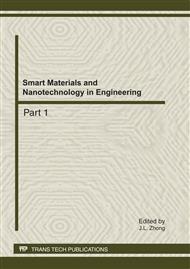[1]
J. S. Seo, D. Whang, H. Lee, et al, A homochiral metal-organic porous materal for enantioselective separation and catalusis, Nature, vol. 404, pp.982-986, (2000).
DOI: 10.1038/35010088
Google Scholar
[2]
B. Chen, M. Eddaoudi, S. T. Hyde, et al, Interwoven metal-organic framework on a periodic minimal surface with extra-large pores, Science, vol. 291, pp.1021-1023, (2001).
DOI: 10.1126/science.1056598
Google Scholar
[3]
O. Sato, T. Iyoda, A. Fujishima, et al, Electrochemically tunable magnetic phase transition in a high-Tc chromium cyanide thin film, Science, vol. 271, pp.49-51, (1996).
DOI: 10.1126/science.271.5245.49
Google Scholar
[4]
O. Kahn, C. Martinez, Spin-transition polymers: from molecular materials toward memory devices, Science, vol. 279, pp.44-48, (1998).
DOI: 10.1126/science.279.5347.44
Google Scholar
[5]
B. F. Abrahams, M. G. Haywood, R. Robson, et al, New tricks for an old dog: the carbonate ion as a building block for networks including examples of composition [Cu6(CO3)12{C(NH2)3}8]4- with the sodalite topology, Angew. Chem. Int. Ed., vol. 42, pp.1112-1115, (2003).
DOI: 10.1002/anie.200390292
Google Scholar
[6]
Q. Fang, G. Zhu, M. Xue, et al, A Metal–Organic Framework with the Zeolite MTN Topology Containing Large Cages of Volume 2. 5 nm3, Angew. Chem. Int. Ed., vol. 44, pp.3845-3848, (2005).
DOI: 10.1002/anie.200462260
Google Scholar
[7]
G. Ferey, A hybrid solid with giant pores prepared by a combination fo targeted chemistry, simulation and powder diffraction, Angew. Chem. Int. Ed., vol. 43, pp.6296-6301, (2004).
DOI: 10.1002/anie.200460592
Google Scholar
[8]
G. Calzaferri, N. Gfeller, Thionine in the cage of zeolite L, J. Phys. Chem., vol. 96, pp.3428-3435, (1992).
DOI: 10.1021/j100187a047
Google Scholar
[9]
G. Wirnsberger, G. D. Stucky, Microring lasing from dye-dope silica/block copolymer nanocomposites, Chem. Mater., vol. 12, pp.2525-2527, (2000).
DOI: 10.1021/cm001078h
Google Scholar
[10]
I. Braun, G. Schulz-Ekloff, D. Wöhrle, et al, Synthesis of AlPO4-5 in a microwave-heated, continuous-flow, high-pressure tube reactor, Micropor. Mesopor. Mater., vol. 23, pp.79-81, (1998).
DOI: 10.1016/s1387-1811(98)00180-2
Google Scholar
[11]
H. Li, M. Eddaoudi, M. O'Keeffe, et al, Design and synthesis of an exceptionally stable and highly porous metal-organic framework, Nature, vol. 402, pp.276-279, (1999).
DOI: 10.1038/46248
Google Scholar


